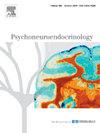Expression of tryptophan hydroxylase in rat adrenal glands: Upregulation of TPH2 by chronic stress
IF 3.4
2区 医学
Q2 ENDOCRINOLOGY & METABOLISM
引用次数: 0
Abstract
It has been shown that chronic restraint stress (CRS) increases adrenal 5-HT levels and turnover through a mechanism that appears unrelated to tryptophan hydroxylase (TPH). In the present study we re-analyzed the effects of CRS (20 min/day) for 14 days relative to control (CTRL) conditions on TPH expression, distribution, and activity in rat adrenal glands. On day 15, adrenal glands were collected for TPH1 and TPH2 immunohistochemistry, Western blot, and RT-PCR; TPH activity was estimated by quantification of 5-hydroxytryptophan (5-HTP) and, indirectly, through measurement of 5-HT and 5-hydroxindolacetic acid (5-HIAA) levels and turnover (5-HIAA/5-HT ratio) by HPLC. TPH expression and activity in the dorsal raphe nucleus (DRN) were also determined for comparison. TPH1 and TPH2 immunostaining was observed in the adrenal medulla, and measurable levels of TPH1 and TPH2 protein and mRNA were detected in rat adrenal glands from CTRL animals. CRS exposure noticeably increased TPH2- but not THP1-immunostaining in the medulla and the outer adrenocortical areas of left (LAG) but not of right adrenal glands (RAG). In addition, CRS exposure increased TPH2 protein and mRNA levels in LAG; however, both measures decreased in DRN. Finally, CRS treatment produced an increase and a decrease of TPH activity and 5-HT turnover in LAG and DRN, respectively. Results indicate that TPH is indeed expressed in rat adrenal glands. Exposure to CRS upregulates TPH2 in LAG, while inducing downregulation of it in the DRN. Then, the increased levels of 5-HT in LAG from CRS-exposed animals likely results from TPH2-mediated synthesis.
大鼠肾上腺中色氨酸羟化酶的表达:慢性应激对 TPH2 的上调
研究表明,慢性束缚应激(CRS)会通过一种似乎与色氨酸羟化酶(TPH)无关的机制增加肾上腺的 5-HT 水平和周转。在本研究中,我们重新分析了相对于对照(CTRL)条件下持续 14 天的 CRS(20 分钟/天)对大鼠肾上腺中 TPH 表达、分布和活性的影响。第 15 天,收集大鼠肾上腺,进行 TPH1 和 TPH2 免疫组织化学、Western 印迹和 RT-PCR 分析;通过量化 5- 羟色氨酸(5-HTP)以及通过 HPLC 间接测量 5-HT 和 5- 羟吲哚乙酸(5-HIAA)的水平和周转率(5-HIAA/5-HT 比率)来估算 TPH 的活性。为了进行比较,还测定了背侧剑突核(DRN)中 TPH 的表达和活性。在肾上腺髓质中观察到 TPH1 和 TPH2 免疫染色,在 CTRL 动物的大鼠肾上腺中检测到可测量水平的 TPH1 和 TPH2 蛋白质和 mRNA。CRS 暴露明显增加了左肾上腺(LAG)髓质和肾上腺皮质外区的 TPH2-免疫染色,但没有增加右肾上腺(RAG)的 THP1-免疫染色。此外,暴露于 CRS 会增加 LAG 中的 TPH2 蛋白和 mRNA 水平;但在 DRN 中,这两项指标都会下降。最后,CRS 治疗分别增加和减少了 LAG 和 DRN 中的 TPH 活性和 5-HT 转化。结果表明,TPH确实在大鼠肾上腺中表达。暴露于 CRS 后,LAG 中的 TPH2 上调,而 DRN 中的 TPH2 下调。那么,暴露于 CRS 的动物 LAG 中 5-HT 水平的增加可能是 TPH2 介导合成的结果。
本文章由计算机程序翻译,如有差异,请以英文原文为准。
求助全文
约1分钟内获得全文
求助全文
来源期刊

Psychoneuroendocrinology
医学-精神病学
CiteScore
7.40
自引率
8.10%
发文量
268
审稿时长
66 days
期刊介绍:
Psychoneuroendocrinology publishes papers dealing with the interrelated disciplines of psychology, neurobiology, endocrinology, immunology, neurology, and psychiatry, with an emphasis on multidisciplinary studies aiming at integrating these disciplines in terms of either basic research or clinical implications. One of the main goals is to understand how a variety of psychobiological factors interact in the expression of the stress response as it relates to the development and/or maintenance of neuropsychiatric illnesses.
 求助内容:
求助内容: 应助结果提醒方式:
应助结果提醒方式:


